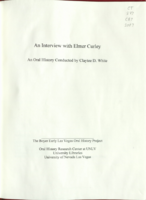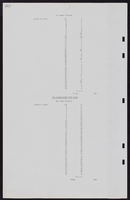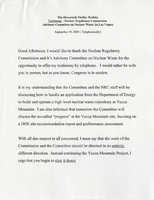Search the Special Collections and Archives Portal
Search Results

Transcript of interview with Leain Vashon by Claytee D. White, July 29, 2014
Date
2014-07-29
Archival Collection
Description
Leain Vashon educated his three children, taken care of any family medical challenge, purchased property, and lived the American Dream because of the Culinary Workers Union Local 226. As a dedicated union man, he has volunteered as shop steward, committee member, organizer, volunteer organizer, and Vice President, an elected position. His children have walked picket lines since five and six years of age. They know the value of their father’s job and his activism in the labor movement. They know that they can be anything they desire. Vashon sees the future as: “The pension that we're going to have is going to be the best pension in the United States. The livable wage we have is going to be some of the highest. The healthcare that we have is going to be one of the best. We are going to insist on those things. We are not going to go backwards. We're not going to go anywhere. The jobs that we do inside the hotel are going to continue to carry dignity. We are going to continue to be the best workers and we are going to give the corporations and the hotels the best that we have to offer. We're going to be great workers. And by having great workers, you are going to have guests who are satisfied because that's the link, how satisfied your worker is and how satisfied your guest is. If every CEO up and down the Strip knew that our fights would be minimal. You take care of the worker; they'll take care of your guest, …and you're going to have the best thing that you can have, which is return guests.”
Text

Transcript of interview with Alan Feldman by Claytee White, September 24, 2014
Date
2014-09-24
Archival Collection
Description
Alan Feldman fell in love with Las Vegas because of the Siegfried & Roy show at the Frontier. After the opening illusion, Crystal Chamber, “I don’t remember breathing.” Feldman grew up in a home with a creative father who was a self-trained musicologist and expert on Paul Robeson. His mother worked as a bookkeeper so Alan was encouraged to be grounded and to soar. As a theater major at UCLA, he was encouraged to hone his Public Relations skills. That expertise brought him to Las Vegas and to Steve Wynn and to work toward a changing relationship with the Culinary Workers Union Local 226. His work here has been life changing; management and labor did not have to fight at the end of each contract. He speaks of the changed understanding in this way: “…we also wanted to make a better product, and in making a better product we needed the employees to step up. Because if you are going to put five million dollars into a restaurant in 1990 where prior to that the most anyone had ever spent was a million, if you were going to tell the world come to Las Vegas because the experience is better, then the experience needed to be better. Maybe this is the part of Steve that he does deserve credit for, although, again, I think it's more—no, he's not alone now and folks like Jim Murren have absolutely taken up this same kind of notion. The building doesn't deliver your bags. The building doesn't hand you the meal. The building doesn't take your order. So great, you've got a volcano and you've got fountains and you've got stunning architecture. Fantastic. But if you don't have a smile on your face when you're welcoming someone to the hotel, it sucks and the rest of it doesn't matter.”
Text

Transcript of interview with Unite Here Bartenders Union Local 165 by Claytee D. White, September 29, 2014
Date
2014-09-29
Archival Collection
Description
Rosemary Christian, David Peinado, Dale Pryor, Virginia Velasquez, and Greg Venezia are among the elite of Las Vegas bartenders. The bars that they work and have worked span from one end of the Strip to the other; the original Aladdin, The Silver Slipper, O’Sheas, the Monte Carlo, Slots ‘A’ Fun, the Luxor, Caesars Palace, and the Rio. Their stories take us from family ownership to corporate. Families allowed all casino bars to be set up in an identical fashion, each type of glass and each liquor bottle was set in the same location all over town. A bartender could walk into a new location and start work without a moment’s hesitation. Corporate thinking changed that need for an outside bartender to work in random places. When women began in this lucrative field, tension occurred but lessened as men recognized that women could lug beer kegs with the best of them and they could easily calm down a drunkard using her womanly touch. The thread throughout this roundtable discussion sews together the exceptional lives of these five bartenders with their membership in UNITE HERE Bartenders Union Local 165. In conjunction with the Culinary Workers Union Local 226, insurance, wages, job satisfaction, uniforms, giving back to the Las Vegas community, and many other benefits occur, seemingly, without effort. “We are skilled craftsmen.” “We have security working for the union and health benefits and a pension. So it's something that's long term. It's longevity working for a union. You know you always have someone backing you.”
Text

Transcript of interview with Dixie and Neil Brundy by Claytee D. White, July 01, 2014
Date
2014-07-01
Archival Collection
Description
Nevadans Dixie Morrison and Neil A. Brundy met in 1959 at a rodeo in St. George, Utah. Born in St. George, Utah, Dixie was raised in Meadow Valley Wash, in Lincoln County, Nevada, on an 800-acre ranch, where she milked cows, barrel-raced, and attend high school via correspondence. Neil lived in Caliente until he was four, when his parents bought ten acres near Rancho Road (US 95) and moved to Las Vegas. Neil attended Fifth Street School, Las Vegas High School, and graduated from Rancho High School’s first graduating class in 1957. The couple married in 1964 in the Little Church of the Flowers and proudly parented six sons. In this interview, the Brundys describe life in rural Nevada and in Las Vegas in the 1940s, 1950s, and 1960s; work on the railroads; barrel-racing; and rodeos. As members of the Church of Jesus Christ of Latter-day Saints, they also talk about their family history work. Their memories evoke the streetscapes of pre- and postwar Las Vegas, its outskirts and downtown; race- and class-based tensions in the schools; the glamour of Las Vegas casinos when they were owned and operated by the mob; and the country music stars who performed downtown. Now residents of Southern Utah, Dixie and Neil come to Las Vegas to hear hardcore rock. Their three youngest sons formed the hardcore rock band, Folsom. When Folsom plays locally the proud parents attend a performance and enjoy family time with their band member sons and the sons and their families who live locally.
Text

Transcript of interview with Dr. John P. Watkins by Claytee D. White, April 29, 2009
Date
2009-04-29
Archival Collection
Description
World War II Naval officer, outdoors man, viola player John Watkins arrived in Las Vegas in 1955 fresh from his fellowship at UCLA, as the town’s first urologist. In this interview made two years before his 2011 death, Watkins talks about his schooling, his medical career, and medicine and medical practitioners in Las Vegas from the mid-1950s. He recalls how he met his wife, Frances (née) O’Rourke, and the Las Vegas places he, Frances, and their sons John and Brian lived. In particular, he describes their Desert Inn Country Club neighbors and neighborhood, where he and his family lived for fourteen years near the third tee. Watkins talks about his musical education and playing the viola in Antonio Morelli’s Christmas concerts. He also shares his experiences as a mountain climber who climbed Mount Charleston several times before deciding in his seventies to climb the highest peak in each of the fifty states. By the time of this interview, he and his son Brian had conquered forty-three state peaks. According to his obituary, he completed one more climb before he died at ninety years of age, for a total of forty-four highest state peaks. In an Appendix, Watkins shares his detailed wartime journal covering nine “terrible days” on a U.S. Naval ship in an undisclosed battle zone in the Pacific Theatre, 28 December 1944 – 6 January 1945.
Text
David Sinclair (University of Nevada, Las Vegas) oral history interview conducted by Kelliann Beavers and Peter Grema: transcript
Date
2022-03-31
Archival Collection
Description
From the Lincy Institute "Perspectives from the COVID-19 Pandemic" Oral History Project (MS-01178) -- Education sector interviews file.
Text

Transcript of interivew with Elmer Curley by Claytee D. White, November 1, 2011
Date
2011-11-01
Archival Collection
Description
Elmer Curley is known simply as Curley. He came to Las Vegas to work in the area of public service for the UNLV library in August 1967. Thus he launched a lifelong move from a smaller community north of Pittsburgh, Pennsylvania to Las Vegas. He only imagined it would be a four to five year move. To his amazement he continue to live here and retired shortly before this interview after a successful career at the library. During this narrative he talks about moving into the University Park Apartments, working with a small budget in the earlier years of the "round building" library, and the humor of receiving book donations that could result in multiple copies of a title. Over the years since 1967, Curley worked with a long list of the various directors observed many changes to the city and experienced the inspiring growth of UNLV.
Text
Pagination
Refine my results
Content Type
Creator or Contributor
Subject
Archival Collection
Digital Project
Resource Type
Year
Material Type
Place
Language
Records Classification



